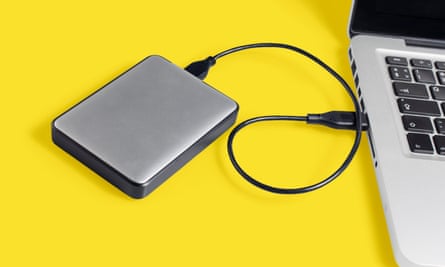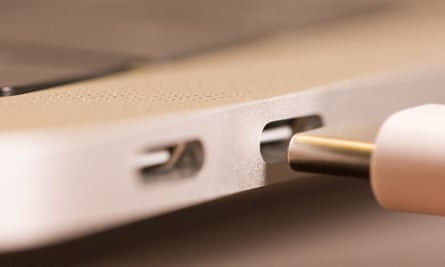My general question is: can a computer that has some of its storage on an external drive with a fast connection (such as Thunderbolt) perform as well as a computer with the same amount of storage inside the computer?
To be specific, I have a 2014 Mac Mini, which is very slow. I am considering upgrading to the latest 2018 version, but I need at least 1TB of storage. Apple can supply the unit with up to 2TB of solid state drive (SSD) storage, but charges an eye-watering £720 per terabyte. If I bought an external Thunderbolt SSD for about £220 per terabyte, would I be likely to see any difference? David
The general question is easy: external drives are slower than comparable internal drives, because the interconnection itself adds an overhead. While you could have a faster external drive, it would be better to spend the money upgrading the internal drive, where possible.
The Guardian’s product and service reviews are independent and are in no way influenced by any advertiser or commercial initiative. We will earn a commission from the retailer if you buy something through an affiliate link. Learn more.
The specific question is impossible to answer because there are so many variables. However, you should be aware that big SSDs are faster than small SSDs, because the controller can write to more modules at the same time. If speed is critical – which I doubt – then a 2TB internal drive will be faster than a 128GB or 250GB internal drive in the same class.
An external SSD’s real-world performance will also depend on many other factors, including the type of storage and the interface chips used. Inside the PC, they include the path to the processor and how many lanes (see below) are available for data.
It also depends on what you are doing. For example, SSDs can stream data much faster than they can read and write random data. You don’t need a fast external drive if you mainly use it for streaming music and videos. However, if you need to do a lot of reads and writes, it’s better to choose an SSD that does those things quickly. That will make far more difference to performance than picking a drive that looks “fast” because it’s good at sequential reads.
Suffice it to say that the best way to tell what kind of external SSD and connection you really need – which could be a version of USB 3.0 rather than Thunderbolt – is to test it with your own software and data. And you probably can’t do that…
However, you should see a dramatic improvement whichever type of storage you choose. You will be comparing your fast new Mac Mini with your slow old one, and this will probably have a much bigger impact than the differences between internal and external SSDs.
The storage hierarchy

Computer storage has always been hierarchical, and today it covers a wide range of speeds and prices. In general, fast, expensive storage lives as close to the processor as possible, with the ultimate being cache memory that is actually on the CPU. At the other extreme, data that is rarely needed can be stored on tapes or Blu-ray discs that may take minutes or even hours to retrieve. These storage systems are very cheap, very slow, and a very long way from the CPU.
There are lots of options between these two extremes. There are fast flash memory cards that slot directly into the computer’s main board, and internal SSDs and hard drives that use Serial ATA connections. SATA II interfaces can handle up to 3Gbps (gigabits per second) or 375MBps (megabytes per second), while SATA III can manage 6Gbps or 750MBps.
After that, there are external hard drives that use either USB (Universal Serial Bus) or Thunderbolt connections. USB 3.0 and USB 3.1 Gen 1 connections have a theoretical bandwidth of 5Gbps or 640MBps, and typically provide 300MBps to 400MBps of throughput, while USB 3.1 Gen 2 can manage twice that.
Thunderbolt connections are even faster. Thunderbolt started at 10Gbps, with a throughput of 700MBps to 800MBps, and today’s Thunderbolt 3 is specified for up to 40Gbps or 5,000MBps of bandwidth. A real-life throughput of around 2,750MBps makes it potentially faster than most internal SSDs, and not far short of the 1TB SSD in the 2018 Mac Mini.
Note that the serial connection speeds, given in Gbps, represent the maximum bandwidth, not the actual throughput. That doesn’t mean the drives are bad. The specifications always leave some headroom to allow for advances in technology, and sometimes they don’t leave enough. For example, SATA II and USB 3.0 were fast enough for traditional hard drives but turned out to be a bottleneck for faster SSDs. We needed SATA III and USB 3.1 Gen 2 to cope with those. Thunderbolt 2 was fast enough to cope with multiple SSDs, but turned out to be a bottleneck for NVMe-based SSDs. (M.2 PCIe NVMe SSDs – yes, that’s a horrible mouthful – are currently the fastest internal SSDs.) Thunderbolt 3 can cope with all but the fastest of those.
Data moves
So, the real question is how much data you need to move, and how fast you need to move it.
Your operating system and programs should fit on the fast SSD inside the Mac Mini, where they will be instantly available, but what about the rest of your data? If you need 1TB for text files, photos, music, and videos, they don’t need to be stored on a high-priced internal SSD. You could move most or all of them to a cheap external hard drive.
Today, you can buy an 8TB external USB 3.0 hard drive for £143.99, or £18 per terabyte. I own a similar WD MyBook, and while it’s comparatively slow, it has no problem playing 1080p full HD videos. It’s certainly much faster than trying to find a particular file in a pile of 1,500 backup DVDs. (I don’t have anything like that many, but if I did, they would fit on an 8TB drive.)
Faster options include USB 3.1 Gen 1 and Gen 2 SSDs (with Type C plugs that fit into Thunderbolt ports), SATA III SSDs (which fit into standard drive bays and external enclosures), and Thunderbolt SSDs.
But as I said, you don’t need operating system speeds on a data drive. If you won’t actually use the 2,750MBps that Thunderbolt 3 can deliver with a fast NVMe SSD, why pay for it?
Why Thunderbolt 3?

The 2018 Mac Mini includes four Thunderbolt 3 ports, which are relatively rare on Windows PCs. This doesn’t mean you’re obliged to use external Thunderbolt 3 SSDs, because – as mentioned – the same port supports USB 3 Type C devices as well. Apple does it because Thunderbolt 3 provides other functions as well.
As Windows PC users will know, PCIe (Peripheral Component Interconnect Express) is the motherboard slot provided for fast graphics cards. It delivers maximum bandwidth via a system of bi-directional “lanes”, each of which can carry almost 8Gbps, in version 3. If your PC has a PCIe x16 graphics card slot, it has 16 lanes and can handle up to 16GBps. This is good for high-resolution video and games.
Basically, Thunderbolt extends the PCIe connection outside the PC.
First, this means you can add a second high-resolution screen to a 2018 Mac Mini. Most users will plug their main screen into the HDMI port, but they can plug another screen into one of the Thunderbolt 3 ports.
Second, it means you can plug in an external graphics card or eGPU, which could be a PC graphics card in a suitable enclosure. The new Mac Mini’s major weakness is that it doesn’t have a discrete graphics card – just the Intel Integrated Graphics that come with the processor – and there is no slot to add one. Thunderbolt 3 is the “get out of jail card” for people who want to use the Mini for 4K video processing or gaming and find the built-in graphics don’t meet their needs.
Third, Thunderbolt 3 can support multiple SSDs, which can be daisy-chained together. USB 3.0 can handle one or perhaps two SSDs. If you have four or more, Thunderbolt 3 is the way to go.
It would, of course, be much more sensible to buy a proper tower with a couple of PCIe slots for graphics cards and room for multiple internal drives. Unfortunately, since the demise of the much-loved “cheese grater” or Power Mac G5, Apple hasn’t offered one. Until it does, the Mac Mini is having to fill the gaping hole for an affordable Mac that doesn’t have a built-in screen.
Have you got a question? Email it to Ask.Jack@theguardian.com

Comments (…)
Sign in or create your Guardian account to join the discussion